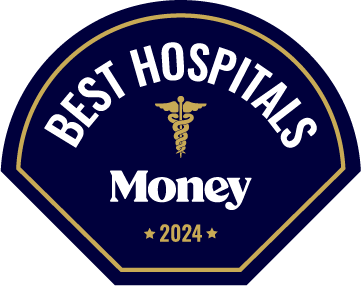In addition to our flagship hospital ranking, Money conducted a separate rating of the best hospitals for pediatric care in March 2024. While our philosophical and methodological approach largely mirrors that of our core Best Hospitals ranking, this sub-list differs in a few key areas.
Rest assured: Our approach still examines highly experienced physicians — in this case, pediatricians — working at safe, high-quality hospitals.
Notably, we brought on an additional data partner, Definitive Healthcare, for this sublist (and subsequent ones). Definitive Healthcare’s sprawling hospital database allowed Money to fine-tune our methods for pediatric care.
Here’s a closer look.
Starting with high-quality facilities
In the U.S., there are over 6,000 hospitals. To narrow this list down, we first started with facilities that have received either a four- or five-star quality rating from the Centers for Medicare & Medicaid Services (CMS).
The CMS rating (included on the list of hospitals as “federal rating”) is based on five key factors that are weighted as follows:
- Mortality (22%): measures the death rates related to cardiovascular issues, strokes, pneumonia and treatable complications after surgery
- Safety (22%): tracks the rate of infections associated with certain surgeries, IVs and catheters and rates of complications after specific procedures
- Readmission (22%): considers how often some patients are readmitted to the hospital, along with how long they stayed and whether there were unplanned visits for outpatient treatment
- Patient experience (22%): gauges whether patients had a positive experience based on their self-reported ratings of how well their doctors and nurses communicated with them; other factors include whether their bathroom was clean and their room was quiet at night
- Timely and effective care (12%): estimates how quickly patients received care for chest pain or strokes; how long they stayed during an ER visit; percent of health care staff who are vaccinated for flu and COVID-19 and other time-sensitive metrics
Highlighting pediatric expertise
Next, we leverage a novel way that Denniston Data, our original data partner, measures quality care: by identifying high-performing doctors and other providers based on their level of experience with certain procedures. We then reward hospitals for their staffs’ collective experience in the form of a Composite Ranking Score (CRS). To be considered for this sub-ranking, facilities must have active pediatricians on staff to be measured by pediatric experience.
The CRS is a percentile that gets translated into a letter grade. The letter grading system is based on this percentage range:
- A+ is a CRS score of 95% to 100%.
- A is 85% to 94.99%.
- A- is 80% to 84.99%.
- B+ is 75% to 79.99%.
- B is 65% to 74.99%.
- B- is CRS 60% to 64.99%.
- C+ is 55% to 59.99%.
- C is 45% to 54.99%.
- C- is 40% to 49.99%.
- D+ is 35% to 39.99%.
- D is 25% to 34.99%.
- D- is 20% to 24.99%.
- F is below 20%.
Whereas this score was the core ranking factor for the best general hospitals, Money weighted this category at 70% for the pediatric care ranking.
Additionally, we considered whether a hospital has a pediatric trauma center designation from a state accrediting body and/or the American College of Surgeons. (A hospital may have both or neither.) These designations range on a scale of Level V to Level I, from least to greatest.
A Level V pediatric trauma center has the basic resources to stabilize children in the event of an emergency and can arrange to have them transferred to a higher level of care at a different hospital. A Level I trauma center, by contrast, provides around-the-clock comprehensive emergency care, surgery and rehabilitation services. Pediatric trauma designations are weighted at 20%.
Finally, Money considered both quality-care metrics as well as the patient experience in a hospital’s overall score for this sub-ranking — and not just as a basic filter. Displayed on our list of the best hospitals for pediatric care, you will find both the CMS’s federal rating out of five stars and, separately, a five-star rating based on the experience of patients during their hospital visit.
The patient-experience rating includes factors such as attentiveness and clear communication from hospital staff — key factors for any pleasant hospital stay, but it’s especially crucial for doctors who are dealing with young patients to be excellent communicators. CMS ratings constitute the remaining 10% of a hospital’s overall score.
Measuring price transparency
The ability to accurately know in advance what a procedure or visit will cost you is vital to avoiding surprises and accurately planning the financial impact of a hospitalization. As an additional criterion to help you choose a hospital, Money developed a price transparency grade for each hospital we ranked. This financial metric is separate from a hospital's overall score, which focuses on quality and experience.
After consulting health care data experts at Denniston and the nonprofit RAND Health Care, Money analyzed the extent to which a hospital’s publicly listed prices (known as chargemaster prices) accurately align with the revenue the hospital receives from patients or Medicare. In effect, we wanted to know: Is the listed price similar to the amount that you’re billed after you’re discharged?
We used two ratios to measure this. The first compares the hospital's chargemaster prices and its gross patient revenue, whether paid by uninsured patients or insurance companies; the second ratio is between the gross billed amount and the total amount approved by Medicare. Weighted equally, these ratios were standardized on a 100-point scale and translated into a letter grade based on the same ranges as listed above for the CRS.
The result: our Price Transparency measure. The lower a hospital’s grade on this measure, the wider the gap between its list prices and what patients have actually paid; the higher the grade, the smaller the difference between the facility’s public prices and the actual bills it issues.
In almost all cases, patients pay less — and often far less — than the publicly listed prices. While this practice is technically discounting, the reality is that many hospitals publicly listed exorbitant chargemaster prices that then get negotiated down by insurers, the federal government or the patients themselves behind closed doors, thus obfuscating what hospital care truly costs and keeping prices high overall.
Keep in mind that the price transparency grade does not necessarily mean that a hospital with a B+ is cheaper than the hospital with a C. Rather, it means its publicly listed prices are more accurate, which can better help you financially prepare.
Vetting top-scoring hospitals
To determine the winners, Money individually vetted the top-rated hospitals according to the standards of our best hospitals methods to account for any red flags that aren't evident in the data.
Money excluded several hospitals for either scandals where patient care was compromised (such as upheld complaints of sexual assault, racial discrimination or unnecessary treatment). We additionally excluded hospitals with a top specialty that focused on adult-only care such as geriatric or internal medicine.
The result is the top 75-rated hospitals for quality pediatric care, handpicked by Money’s editorial team.
Note: Based on our methods and the availability of reliable data, Money did not specifically rank children’s hospitals, which are a subset of specialty hospitals. Instead, our ranking is of short-term acute care facilities with a workforce of highly experienced pediatric doctors. According to the Children’s Hospital Association, there are only about 220 children’s hospitals in the U.S., and they are dispersed unevenly across the country — with several states only having one and some states having zero. By and large, these hospitals do not participate in CMS’s quality reporting surveys, thus disqualifying them from inclusion.
Data sources: Denniston Data Inc; Definitive Healthcare
Supplementary data: Agency for Healthcare Research and Quality; Centers for Medicare & Medicaid Services; RAND Health Care




